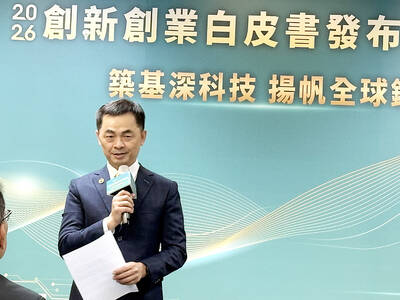Vacancy rates for grade A offices in Taipei dropped to 2.36 percent last quarter as robust demand and a lack of new supply helped the market avoid the effects of the COVID-19 pandemic, Jones Lang LaSalle Inc (JLL) said on Tuesday.
The office market is poised to benefit from a sustained recovery, with a 3 to 5 percent increase in rents for the rest of this year, the local branch of the US broker said.
The second quarter saw a take-up rate of 3,212 ping (10,618m2), keeping vacancy rates at their second-lowest level in history, JLL Taiwan senior market director Brian Liu (劉建宇) told a news conference in Taipei, calling the forecast conservative amid tight supply.
“Rents at landmark buildings in the city’s prime Xinyi District (信義) already soared by double-digit percentage points this year, and landlords will continue to have the upper hand,” said Liu, whose company controls more than 50 percent of the local leasing market.
Taipei’s resilient showing bucked regional trends, as vacancy rates rose 6.7 percent in Seoul, 1.7 percent in Singapore, 1.2 percent in Hong Kong and 1.1 percent in Beijing, JLL data showed.
The pandemic is accelerating supply chain realignment as evidenced by the Ministry of Economic Affairs receiving investment pledges of more than NT$1 trillion (US$33.78 billion) by the middle of May, JLL said.
Taiwan’s efficiency in containing the spread of COVID-19 would enable companies to proceed with investment plans on schedule, whereas in many other parts of the world, attempts at expansion have been pushed back by lockdowns, the company said.
Rents held steady from the previous quarter at NT$2,809 per ping, with rents in Xinyi standing at NT$3,411 per ping, still more affordable than upscale offices in other international cities, JLL said.
JLL Taiwan managing director Tony Chao (趙正義) said that the pandemic might permanently reshape people’s lives, including working arrangements.
Remote working and learning would stay and gain traction, as would the coworking model, which would reduce the need for physical office space, Chao added.
However, companies would maintain greater space between staffers and set aside more social areas in the post-pandemic era to help employees stay healthy and motivated, meaning that overall office space might remain at similar levels, Chao said.

CHIP RACE: Three years of overbroad export controls drove foreign competitors to pursue their own AI chips, and ‘cost US taxpayers billions of dollars,’ Nvidia said China has figured out the US strategy for allowing it to buy Nvidia Corp’s H200s and is rejecting the artificial intelligence (AI) chip in favor of domestically developed semiconductors, White House AI adviser David Sacks said, citing news reports. US President Donald Trump on Monday said that he would allow shipments of Nvidia’s H200 chips to China, part of an administration effort backed by Sacks to challenge Chinese tech champions such as Huawei Technologies Co (華為) by bringing US competition to their home market. On Friday, Sacks signaled that he was uncertain about whether that approach would work. “They’re rejecting our chips,” Sacks

NATIONAL SECURITY: Intel’s testing of ACM tools despite US government control ‘highlights egregious gaps in US technology protection policies,’ a former official said Chipmaker Intel Corp has tested chipmaking tools this year from a toolmaker with deep roots in China and two overseas units that were targeted by US sanctions, according to two sources with direct knowledge of the matter. Intel, which fended off calls for its CEO’s resignation from US President Donald Trump in August over his alleged ties to China, got the tools from ACM Research Inc, a Fremont, California-based producer of chipmaking equipment. Two of ACM’s units, based in Shanghai and South Korea, were among a number of firms barred last year from receiving US technology over claims they have

BARRIERS: Gudeng’s chairman said it was unlikely that the US could replicate Taiwan’s science parks in Arizona, given its strict immigration policies and cultural differences Gudeng Precision Industrial Co (家登), which supplies wafer pods to the world’s major semiconductor firms, yesterday said it is in no rush to set up production in the US due to high costs. The company supplies its customers through a warehouse in Arizona jointly operated by TSS Holdings Ltd (德鑫控股), a joint holding of Gudeng and 17 Taiwanese firms in the semiconductor supply chain, including specialty plastic compounds producer Nytex Composites Co (耐特) and automated material handling system supplier Symtek Automation Asia Co (迅得). While the company has long been exploring the feasibility of setting up production in the US to address

OPTION: Uber said it could provide higher pay for batch trips, if incentives for batching is not removed entirely, as the latter would force it to pass on the costs to consumers Uber Technologies Inc yesterday warned that proposed restrictions on batching orders and minimum wages could prompt a NT$20 delivery fee increase in Taiwan, as lower efficiency would drive up costs. Uber CEO Dara Khosrowshahi made the remarks yesterday during his visit to Taiwan. He is on a multileg trip to the region, which includes stops in South Korea and Japan. His visit coincided the release last month of the Ministry of Labor’s draft bill on the delivery sector, which aims to safeguard delivery workers’ rights and improve their welfare. The ministry set the minimum pay for local food delivery drivers at